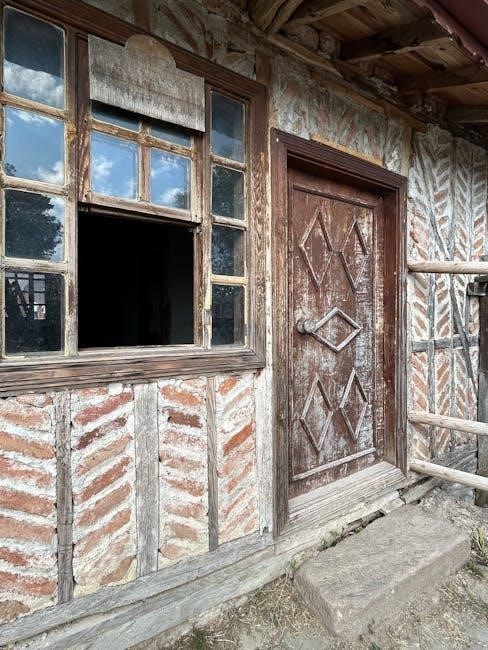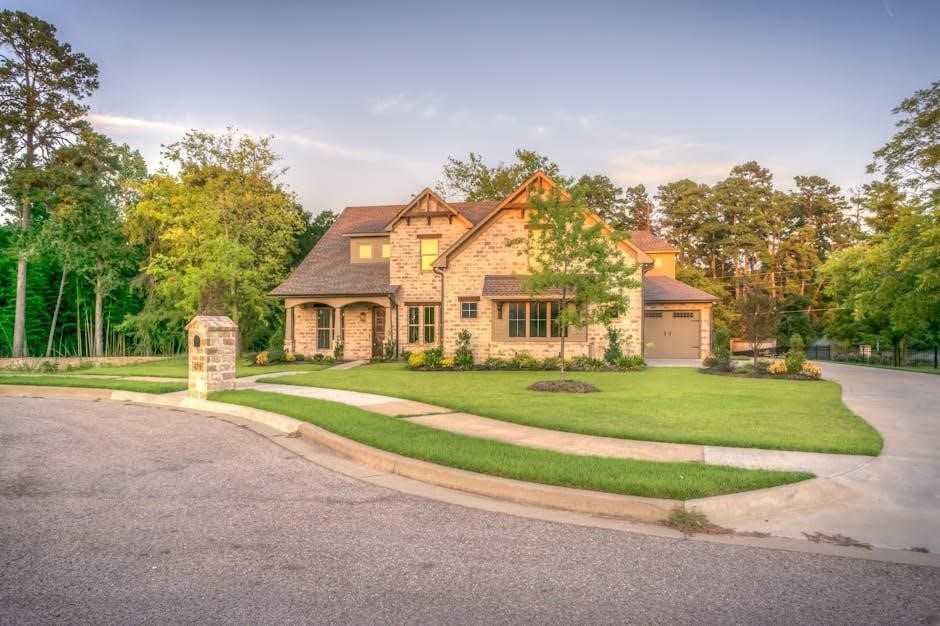Building a home is a significant undertaking requiring careful planning and organization. This checklist serves as a comprehensive guide to simplify the process and ensure success.
Pre-Construction Planning
Pre-construction planning is crucial for a smooth project. It involves evaluating the site, defining timelines, and aligning design preferences with your budget for a successful build;
2.1. Site Analysis
Site analysis is the first step in pre-construction planning, ensuring your land is suitable for building. Assess topography, soil conditions, and drainage to avoid costly surprises. Check for environmental factors like wetlands or flood zones. Evaluate access to utilities and services. Consider zoning laws and neighborhood restrictions. Determine the best orientation for sunlight and wind patterns. Conduct soil tests to identify stability and suitability for foundations. Review local regulations and easements. Ensure proper grading to prevent water pooling. Lastly, consult professionals to verify the site’s feasibility for your project. This step lays the foundation for a successful and stress-free building experience.
2.2. Location Selection
Choosing the right location is a critical step in building your home. Consider proximity to schools, workplaces, and amenities like shopping centers and hospitals. Evaluate commute times and public transportation options. Research neighborhood safety, community vibe, and local schools’ reputations. Assess environmental factors such as climate, noise levels, and access to outdoor spaces. Check for zoning restrictions and future development plans in the area. Ensure the location aligns with your lifestyle and long-term goals. Visit potential sites at different times to gauge traffic and noise. Lastly, consult with local experts to gain insights into the area’s growth potential. A well-chosen location enhances your quality of life and property value.
2.3. Zoning and Regulations
Understanding local zoning laws and regulations is essential before breaking ground. Research the area’s zoning ordinances to ensure your home design complies with size, height, and setback requirements. Verify if there are restrictions on architectural styles or materials. Obtain necessary permits and approvals from local authorities. Familiarize yourself with building codes, fire safety standards, and environmental regulations. Ensure compliance with neighborhood covenants or homeowners’ association rules, if applicable. Address any easements or property line disputes early. Consulting with local officials or legal experts can help navigate complex requirements. Proper compliance avoids costly delays or fines, ensuring a smooth construction process.

Budgeting and Financial Planning
Establishing a clear budget is essential for managing expenses. Include costs for materials, labor, permits, and contingencies. Regularly review and adjust to avoid overspending.
3.1. Cost Estimation
Accurate cost estimation is critical for a successful home building project. Start by breaking down expenses into materials, labor, permits, and inspections. Research current market prices for materials, such as lumber, electrical systems, and plumbing fixtures. Labor costs vary by location and contractor expertise, so gather detailed quotes. Include expenses for permits, inspections, and potential contingencies. Use a checklist to organize these estimates and ensure no costs are overlooked. Regularly review and update your budget to reflect changes in material prices or project scope. A well-planned cost estimation helps avoid financial surprises and keeps your project on track. Consider consulting with professionals to verify your estimates and ensure accuracy.
3.2. Financing Options
Exploring financing options is a crucial step in your home building journey. Research construction loans, which cover costs during the building phase, and mortgage options for long-term financing. Consider down payment requirements and compare interest rates from various lenders. Some builders offer financing partnerships, so inquire about their preferred vendors. Additionally, pre-approval for a loan can help establish a realistic budget. Review terms carefully, including repayment schedules and penalties. Factor in long-term financial implications, such as fixed-rate vs. adjustable-rate loans. Proper financial planning ensures your project stays within budget and aligns with your financial goals. Consulting with a financial advisor can also provide personalized strategies for securing the best financing solution.
3.3. Contingency Planning
Contingency planning is essential to address unexpected challenges during home construction. Set aside a portion of your budget for unforeseen expenses, such as material price increases or delays. Identify potential risks like weather conditions or supply chain issues and develop backup plans. Ensure contractors provide guarantees for their work and obtain written estimates to avoid disputes. Regularly review your timeline and budget to adapt to changes. Maintaining a contingency plan reduces stress and ensures the project stays on track. By preparing for the unexpected, you can navigate obstacles smoothly and achieve your vision without compromising quality or timelines.

Hiring Contractors
Hiring reliable contractors is a critical step in home building. Start by researching licensed professionals with experience in your project type. Check online reviews, ask for references, and verify their credentials. Obtain detailed bids from multiple contractors to compare costs and services. Ensure they are insured and bonded to protect against liability. Discuss their approach to communication and project management to maintain transparency. Ask about their network of subcontractors and suppliers to ensure consistency. Clearly outline expectations in a written contract, including timelines, payment terms, and warranties. Finally, verify their willingness to accommodate your design preferences and material choices. A trustworthy contractor is key to a smooth and successful building process.
Obtaining Permits
Obtaining the necessary permits is a crucial step in the home building process to ensure compliance with local regulations. Research the types of permits required, such as building, electrical, and plumbing permits. Contact your local government or zoning office to understand the specific requirements. Submit detailed plans and blueprints for approval, and be prepared to pay associated fees. Delays in obtaining permits can halt construction, so plan ahead and allow ample time for processing. Ensure all inspections are scheduled and passed before moving to the next phase. Keep copies of all permits and approvals for your records. Failure to obtain proper permits can result in fines or even project shutdowns, making this step essential for a smooth construction process.
Home Design
Designing your home is an exciting and creative phase where your vision takes shape. Start by working with architects or designers to create a functional and aesthetically pleasing layout. Consider your lifestyle, space requirements, and personal preferences when selecting a design style. Ensure the plan aligns with your budget and site constraints. Choose materials and finishes that reflect your taste while maintaining durability. Incorporate energy-efficient features and smart home technologies for modern convenience. Review and finalize the blueprint, ensuring it meets local building codes and regulations. Make sure to balance aesthetics with practicality, considering future needs like flexibility for family growth or aging-in-place features. A well-thought-out design sets the foundation for a home that is both beautiful and functional, making the construction process smoother and more enjoyable.

Material Selection
Selecting the right materials is a critical step in building your home, as it impacts both aesthetics and functionality. Research and compare different materials based on durability, cost, and sustainability. Consider factors like climate, maintenance requirements, and energy efficiency. Work with your contractor to identify trusted vendors and suppliers. Ensure all materials comply with local building codes and regulations. Create a list of essential items, such as lumber, roofing materials, insulation, and finishes. Prioritize quality over cost to avoid future repairs or replacements. Additionally, consider eco-friendly options if sustainability is a priority. Verify warranties and guarantees for each material. A well-planned material selection process ensures your home is built to last while meeting your design and budget goals. Proper organization and communication with your team are key to avoiding delays or mismatches.
Construction Phases
Construction phases are the backbone of your home-building project, ensuring a systematic approach from start to finish. Begin with site preparation, including clearing land and grading. Next, lay the foundation, whether slab, crawl space, or full basement. Framing comes next, defining the structure’s shape and layout. Install electrical, plumbing, and HVAC systems, followed by insulation and drywall. Exterior finishes like roofing and siding are then added. Interior work includes installing flooring, cabinets, and countertops. Painting and finishing touches, such as trim and fixtures, complete the interior. Conduct final inspections and address any issues before occupancy. Each phase requires careful planning and quality checks to ensure a smooth transition to the next. Adhering to this sequence guarantees your home is built safely, efficiently, and to your specifications.
Inspections
Inspections are a critical step in the home-building process, ensuring compliance with local codes and standards. Conduct a foundation inspection before pouring concrete to verify footings and walls are correctly placed. After framing, schedule a framing inspection to check structural integrity. Electrical, plumbing, and HVAC systems require separate inspections to ensure they meet safety regulations. A final inspection is performed before occupancy to verify all work is complete and up to code. These inspections prevent costly repairs and ensure your home is safe and durable. Keep records of all inspection reports for future reference. Regular inspections also help identify potential issues early, saving time and money. They provide peace of mind and are a critical safeguard in your home-building journey.

Fixtures and Appliances
Selecting the right fixtures and appliances is a vital part of the home-building process. These elements not only enhance functionality but also contribute to the overall aesthetic of your home. Start by choosing lighting fixtures, plumbing fixtures, and appliances that align with your design preferences and budget. Consider energy efficiency and durability when making your selections. Coordinate with your contractor to ensure all items are ordered and delivered on time. Verify that fixtures and appliances meet local safety standards and building codes. Keep track of warranties and installation requirements; Additionally, confirm that electrical and plumbing systems are compatible with your chosen fixtures and appliances. Finally, schedule installations strategically to avoid delays in the construction timeline. Proper planning ensures a seamless integration of these essential components.
Final Touches
The final touches are the last steps before your home is complete. Review the punch list to ensure all items are addressed. Conduct a final cleaning of all rooms, including windows and floors. Inspect all systems, such as HVAC, plumbing, and electrical, to confirm they are functioning properly. Coordinate with contractors to address any remaining issues or touch-ups. Ensure all finishes, such as paint and trim, are complete and meet your expectations. Review and organize all documentation, including warranties and manuals for fixtures and appliances. Schedule a final walk-through with your builder to verify everything is satisfactory. Once everything is approved, your home will be ready for occupancy. Properly completing these final steps ensures your home is move-in ready and meets your standards.
Post-Construction Steps
After construction is complete, several steps ensure your home is fully functional and ready for occupancy. Begin by reviewing and organizing all warranties and maintenance instructions for fixtures, appliances, and systems. Schedule a final inspection with local authorities to obtain a certificate of occupancy. Conduct a thorough cleaning of the entire property, including landscaping and exterior features. Address any minor touch-ups or repairs identified during the final walk-through. Ensure all keys, remotes, and access devices are handed over. Review and finalize all payments with contractors and suppliers. Update your insurance to reflect the completed home and adjust utility accounts. Finally, complete any necessary paperwork and document everything for future reference. These steps ensure a smooth transition into your new home.
Building a home is a complex journey that requires meticulous planning, organization, and attention to detail. This ultimate home building checklist has guided you through every critical step, from pre-construction planning to post-construction steps. By following this comprehensive guide, you can ensure that your project stays on track, adheres to budgets, and meets your expectations. Remember, careful preparation and consistent communication with contractors and designers are key to achieving your dream home. With this checklist, you can tackle challenges confidently and enjoy the satisfaction of creating a space tailored to your needs. Celebrate the completion of your home and the memories it will hold for years to come.
